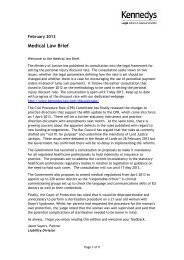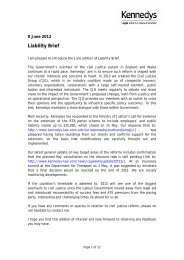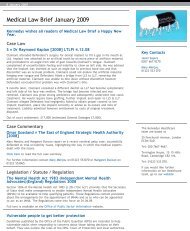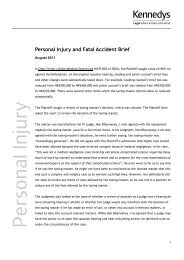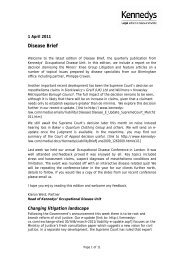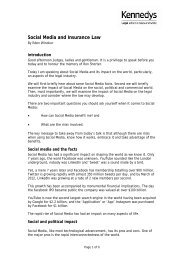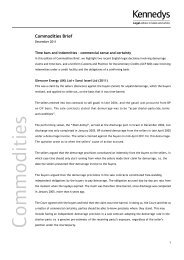Download The Key - Winter 2012 (PDF, 468KB) - Kennedys
Download The Key - Winter 2012 (PDF, 468KB) - Kennedys
Download The Key - Winter 2012 (PDF, 468KB) - Kennedys
You also want an ePaper? Increase the reach of your titles
YUMPU automatically turns print PDFs into web optimized ePapers that Google loves.
Taking a consistent approach<br />
<strong>The</strong> EU proposes a major overhaul of the medical devices rules.<br />
<strong>The</strong> European Commission has<br />
recently published its plans for<br />
revising the current regulations<br />
governing medical devices in<br />
Europe. <strong>The</strong> new proposals aim to<br />
ensure that the rules for such<br />
products are applied consistently<br />
across all EU member states. If<br />
implemented, they will cover all<br />
medical devices marketed within<br />
the EU and replace the current<br />
directives dealing with medical,<br />
active implantable medical and in<br />
vitro diagnostic medical equipment.<br />
<strong>The</strong> proposals come at a moment when the<br />
current regulatory system is under close<br />
scrutiny, following the recent controversy over<br />
the manufacture of silicone breast implants by<br />
the French company, Poly Implant Prothese,<br />
which did not conform to specification.<br />
<strong>The</strong> proposals will affect<br />
everyone who is involved in<br />
the manufacture of medical<br />
devices and their supply to<br />
patients and consumers.<br />
Background to the proposals<br />
<strong>The</strong> scope of these proposals is extremely wide,<br />
encompassing the whole range of medical<br />
devices from the simplest of products such as<br />
sticking plaster to the most sophisticated x-ray<br />
and life support machinery. <strong>The</strong> proposals will<br />
affect everyone who is involved in the<br />
manufacture of medical devices and their supply<br />
to patients and consumers.<br />
<strong>Key</strong> points<br />
<strong>The</strong> legislation will take the form of regulations<br />
rather than directives. Whereas a directive<br />
would require transposition into the law in each<br />
Member State, the use of regulations ensures<br />
they will come into effect immediately in all<br />
EU countries.<br />
<strong>The</strong> key changes can be summarised as follows:<br />
• <strong>The</strong> definition of medical devices will be<br />
widened and clarified to ensure that all<br />
devices are assessed for safety before being<br />
placed on the EU market.<br />
• <strong>The</strong>re will be stronger supervision of national<br />
“notified bodies” by EU Member States –<br />
the independent assessment organisations<br />
tasked with granting pre-market<br />
authorisations – to ensure effective<br />
premarketing assessment of devices.<br />
• Notified bodies will also be given greater<br />
powers to ensure quality control. This will<br />
include being able to make unannounced<br />
factory inspections and carrying out sample<br />
testing on devices.<br />
<strong>The</strong>se proposals will result in<br />
far closer monitoring of the<br />
manufacture, distribution and<br />
post-marketing surveillance of<br />
medical devices within the EU.<br />
• A unique device identification (UDI) system<br />
will be introduced for all devices with the aim<br />
of improving post-market traceability and<br />
speeding up alert notifications.<br />
• A centralised EU-wide database will be<br />
created where manufacturers, their<br />
authorised representatives and importers will<br />
register themselves and their products,<br />
making use of the UDI system.<br />
• Manufacturers of high-risk devices will have<br />
to provide summaries of safety and clinical<br />
data for such equipment and make this<br />
information publicly available.<br />
• Manufacturers will be required to have at<br />
least one ‘Qualified Person’, as defined by the<br />
regulations, who is responsible for compliance<br />
with medical device regulatory requirements.<br />
• <strong>The</strong> European databank on medical devices<br />
will be further developed so as to improve<br />
transparency and public access.<br />
• <strong>The</strong>re will be better market surveillance and<br />
vigilance, supported by “national competent<br />
authorities” such as the UK’s Medicines and<br />
Healthcare products Regulatory Agency<br />
(MHRA), which is responsible for ensuring that<br />
medicines and medical devices work and are safe.<br />
• An EU-level medical device co-ordination<br />
group, staffed by experts, will be established.<br />
It will scrutinise devices before they are<br />
placed on the EU market and keep the<br />
European Commission advised about<br />
implementation of the new regulations.<br />
Too much regulation can delay<br />
life-saving products coming to<br />
market and undermine research<br />
and development.<br />
Comment<br />
<strong>The</strong>se proposals will result in far closer<br />
monitoring of the manufacture, distribution and<br />
post-marketing surveillance of medical devices<br />
within the EU. However, they are more of a<br />
7



